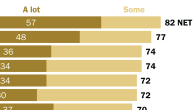This profile provides key demographic information on Latino eligible voters1 and other major groups of eligible voters in Rhode Island.2 All demographic data are based on Pew Hispanic Center tabulations of the U.S. Census Bureau’s 2010 American Community Survey.3
Hispanics in Rhode Island’s Eligible Voter Population
- The Hispanic population in Rhode Island ranks 37th in the nation.4 About 131,000 Hispanics reside in Rhode Island, 0.3% of all Hispanics in the United States.
- Rhode Island’s population is 12% Hispanic, the 13th largest Hispanic population share nationally.
- There are 54,000 Hispanic eligible voters in Rhode Island—ranks 35th in Hispanic eligible voter population nationally. California ranks first with 5.9 million.
- Some 7% of Rhode Island eligible voters are Hispanic, the 13th largest Hispanic eligible voter population share nationally. New Mexico ranks first with 39%.
- More than four-in-ten (41%) Hispanics in Rhode Island are eligible to vote, ranking Rhode Island 21st nationwide in the share of the Hispanic population that is eligible to vote. By contrast, more than eight-in-ten (81%) of the state’s white population is eligible to vote.

Characteristics of Eligible Voters
- Age. Fully 37% of Hispanic eligible voters in Rhode Island are ages 18 to 29, greater than the share of all Latino eligible voters nationwide (33%) in that age range. By contrast, only 22% of all Rhode Island eligible voters and of all U.S. eligible voters are ages 18 to 29.
- Citizenship and Nativity. Among Hispanic eligible voters in Rhode Island, one-third (33%) are naturalized U.S. citizens. This compares with 25% of Hispanic eligible voters in the U.S., but just 8% of all eligible voters in the state and nationwide.
- Hispanic Origin. Hispanic eligible voters in Rhode Island have a different Hispanic origin profile from Hispanic eligible voters nationwide. Puerto Ricans make up 41% of Hispanic eligible voters and Dominicans are another 28%, while those of Mexican origin total 7%. This is a contrast to the U.S. overall, where nearly six-in-ten Hispanic eligible voters (59%) are Mexican, 14% are Puerto Rican, and 3% are Dominican.
- Educational Attainment. More than one-quarter of Latino eligible voters in Rhode Island (27%) have not completed high school, about double the 13% of all Rhode Island eligible voters who have not completed high school.
- Homeownership. Some 38% of Hispanic eligible voters in Rhode Island live in owner-occupied homes, less than the share of all Hispanic eligible voters nationwide (58%). Greater shares of all eligible voters in Rhode Island (65%) and all eligible voters nationwide (69%) live in owner-occupied homes.

Characteristics of Eligible Voters in Rhode Island, by Race and Ethnicity
- Number of Eligible Voters. White eligible voters outnumber Hispanic eligible voters in Rhode Island by a 12-to-1 margin. However, there are more Hispanic eligible voters in the state (about 54,000) than black eligible voters (34,000).
- Age. Latino eligible voters are younger than black and white eligible voters in Rhode Island. Some 37% of Latinos are ages 18 to 29, compared with 32% of black eligible voters and 20% of white eligible voters.
- Educational Attainment. Hispanic eligible voters have lower levels of education than do black and white eligible voters in Rhode Island. Some 27% of Hispanic eligible voters have not obtained a high school diploma, compared with 21% of black eligible voters and 11% of white eligible voters.
- Homeownership. Hispanic eligible voters (38%) are slightly more likely to live in owner-occupied homes than black (37%) eligible voters in Rhode Island, but they are less likely to do so than white (69%) eligible voters.





